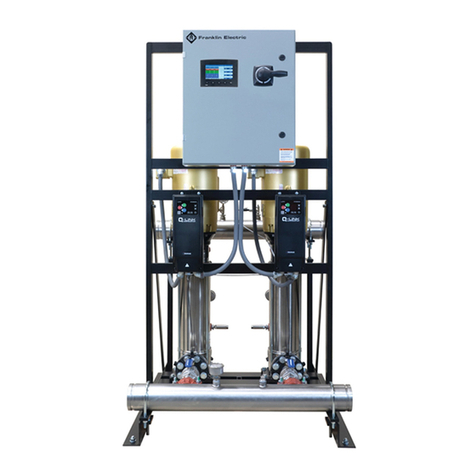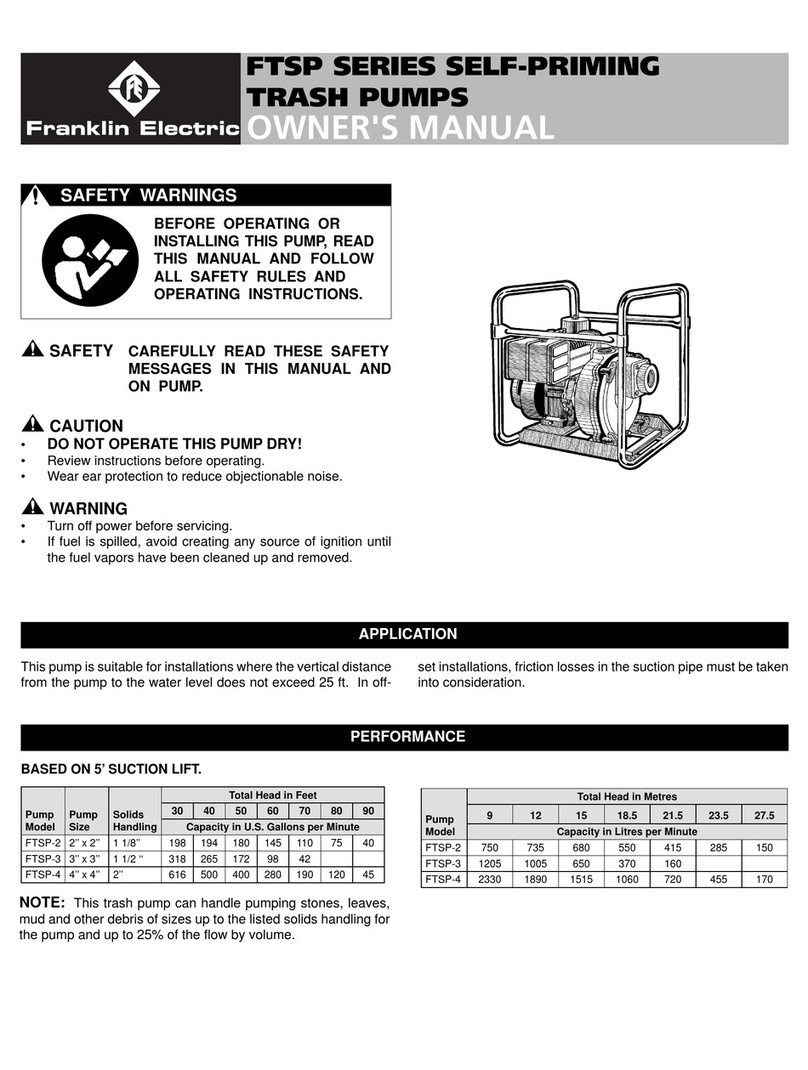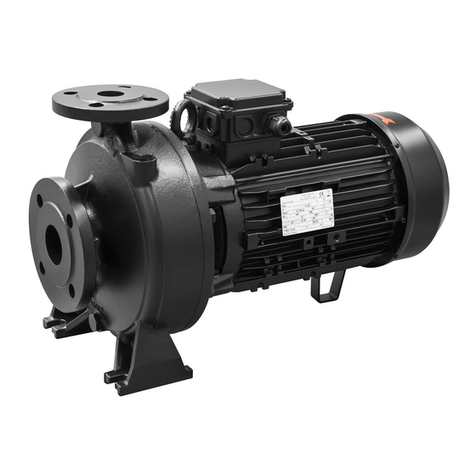
INSTALLATION
This manual provides installation, operation and mainte-
nance instructions for your Franklin Electric pump. The
manual will also make your personnel aware of any pro-
cedure that requires special attention because of potential
hazards to personnel or equipment. Read all instructions
carefully and remember this manual cannot anticipate or
warn of every situation that could occur. Because of this it
is the owners responsibility that only safe procedures be
used, if not addressed in this manual. If any question re-
garding the pump is not covered adequately please con-
tact you Franklin Electric representative.
This manual also provides a troubleshooting section to di-
agnose many operational or performance problems. The
equipment covered in this section is limited to the pump
only. Refer to the applicable vendor’s manual for motors,
engines and other accessory equipment. Use the trou-
bleshooting section to help determine the cause of any
problems, and only disassemble the pump components
required to remedy the existing condition.
FOUNDATION/BASE PLATE/SKID
If using a concrete foundation it should be rigid enough
to inhibit vibration. Pour the foundation well in advance
of installation of pump equipment to allow time for drying
and curing.
If the pump is to be mounted on a steel frame, or simi-
lar structure, it should be set directly over the support-
ing beams. These beams and the structure must be rigid
enough to prevent distortion and potential misalignment
due to movement within the structure or base. The loca-
tion of this structure should be as close as possible to the
pumpage source. Provide adequate space for operation,
maintenance and inspection of the pump and equipment.
The concrete foundation should be provided with anchor
bolts for attachment to the base plate. If required, pro-
vide adequate drainage to keep pump and motor dry and
clean. Also, provide either leveling nuts or leveling wedges
for mounting the base plate to the foundation.
LEVELING
When mounting the base plate to the foundation use the
leveling nuts or wedges to provide a level, flat base plate.
Use a machinist’s level on the mounting pads and make
adjustments as necessary as the anchor bolts are tight-
ened. This will provide the true alignment between the
pump and motor.
GROUT
If this base plate is to be grouted, ensure that you have
the mounting surface flat and level for correct alignment
of pump and motor. Build a dam around the base plate
perimeter that is to be watertight. Use standard grouting
practice and be sure to protect (cover) the leveling wedges
with caulk or plastic tape if they are to be removed later.
After the grout has thoroughly hardened, remove forms. If
the wedges are removed, fill holes with grout. Seal grout
by covering with a quality paint or sealer.
INSTALLING PUMP
Ensure that all foreign material has been removed from
the pump before mounting. Be sure to remove all shipping
protection prior to operation.
NOTE: Many of the bare pumps are shipped with protec-
tive guards and coatings.
SUCTION PIPING
For best performance the suction piping should be at least
as large as the pump flange, never smaller. Use an ec-
centric reducer at the suction flange with the straight side
up. The use of flow-retarding fittings is to be avoided and,
if necessary should never be placed closer than four (4)
times the pipe diameter to the pump suction. The pump
should be at the highest point of the piping. Slope the
piping up to the pump to prevent air pockets and avoid
changing pipe size with the exception of the eccentric re-
ducer mentioned above. All suction piping and fittings are
to be checked for any foreign material (rocks, bolts, wire,
etc.) and also any sharp burrs that could disrupt the flow.
DISCHARGE PIPING
Use a concentric taper on the discharge side to increase
discharge pipe diameters. All valving and additional fit-
tings should be the same size as the discharge main-line.
The discharge size should be adequate to maintain rea-
sonable velocities and reduce friction losses.
SUCTION & DISCHARGE PIPE FLANGES
All piping is to be supported, braced and lined up square
before connection to the pump flanges. A flexible fitting is
recommended on both suction and discharge, to eliminate
any piping strains being transmitted to the pump.
NOTE: Flexible pipe couplings must be restrained so as not
to transmit any strain to the pump flanges when expanding
or contracting under pressure. Unrestrained expansion fit-
tings can transmit enormous forces to the pump flanges.
SCREENING
Make provisions for the installation of a suction screen or
strainer to prevent any debris from clogging the impeller.
The open area of the strainer should be equal to at least
four (4) times the area of the pipe. The screen should be
rigid enough to prevent collapse when flow is reduced due
to clogging.
SUMP DESIGN
The submergence of the suction pipe into the liquid should
be at least four (4) to five (5) times the pipe diameter. If this
is not possible, then provide a baffle or a floating board to
prevent any vortex action allowing air into the pipe. For
best performance a bell mouth fitting is recommended.
Refer to the Hydraulic Institute Handbooks or other Hy-
draulic Data books for detailed sump design information.
LIFTING
Any lifting equipment is to be rated for at least five (5) times
the weight of the item being lifted. Use only established
methods when lifting or moving any heavy components.



















































